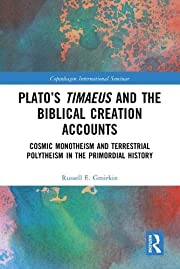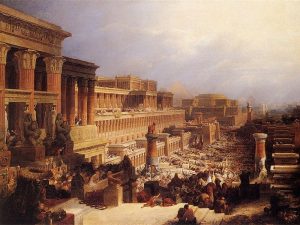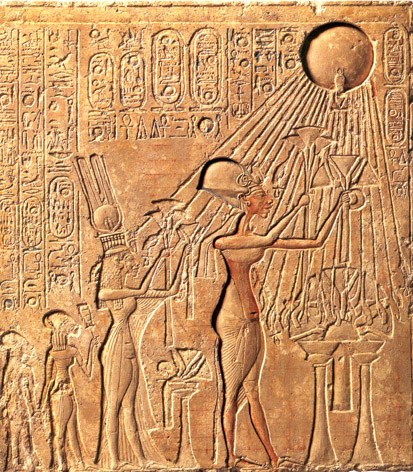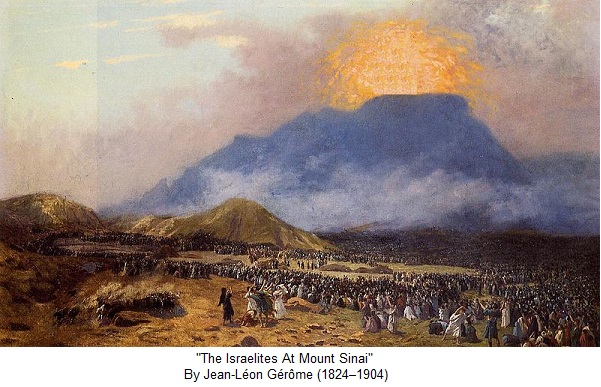 Russell Gmirkin concludes his second last chapter with a look beyond Genesis to highlight the plausibility of Plato’s Timaeus and Critias influencing some of Exodus, Deuteronomy and Joshua.
Russell Gmirkin concludes his second last chapter with a look beyond Genesis to highlight the plausibility of Plato’s Timaeus and Critias influencing some of Exodus, Deuteronomy and Joshua.
In Critias Plato was composing an account of Athenian origins and its political organization, a politogony. Gmirkin cites Naddaf’s The Greek Concept of Nature which I turned to and read how various Greek poets and philosophers were interested in writing accounts that began with a cosmogony, then moved on to an anthropogony or zoogony, and finally came to a politogony — all of which seems to me to encapsulate the structure of Genesis and the Pentateuch: creation of the cosmos is the opening chapter, then the creation of humans and how humans came to be organized as they are across the inhabited world, and finally how thbe nation of Israel came about with its laws, priesthood, tribal organization as well as how its relations with other peoples originated. After writing the above I quickly checked the early chapters of Gmirkin’s book and found he had made just that point from the outset.
Plato’s account of Atlantis is set in mythical time: the god Poseidon married the mortal, Cleito, and fathered five pairs of twins who became princes ruling the ten tribes of the land. These ten leaders ruled independently as kings but swore allegiance to be one with each other in loyalty and policies and keep forever the laws of Poseidon. Those laws were inscribed on a pillar and kept in the temple. Gmirkin is, of course, prompting us to compare this scenario with the organization of Israel and its covenant with Yahweh.
One can point to the many obvious differences between Plato’s Critias and the biblical book of Exodus. My own approach to such comparative studies is to examine how unique the comparisons are and whether we can find in those similarities explanations for the differences that go beyond the ad hoc. The most significant place where a comparison must begin is the fact that in the following scene we look in vain, as far as I am aware, for parallels in the literature of the Levant or Mesopotamia.
National Covenant with Yahweh || National Covenant with Poseidon
Some similarities between Plato’s Critias and the scene of Israel swearing obedience to their god at Mount Sinai in the Book of Exodus:
| Exodus 24:3-8 | Critias 119e-120b |
| Moses came and told the people all the words of the Lord and all the ordinances; and all the people answered with one voice, and said, “All the words that the Lord has spoken we will do.” (4) And Moses wrote down all the words of the Lord. | And whatsoever bull they captured they led up to the pillar and cut its throat over the top of the pillar, raining down blood on the inscription. |
| He rose early in the morning, and built an altar at the foot of the mountain, and set up twelve pillars, corresponding to the twelve tribes of Israel. | And inscribed upon the pillar, besides the laws, was an oath which invoked mighty curses upon them that disobeyed. |
| (5) He sent young men of the people of Israel, who offered burnt offerings and sacrificed oxen as offerings of well-being to the Lord. | When, then, they had done sacrifice according to their laws and were consecrating (120a) all the limbs of the bull, |
| (6) Moses took half of the blood and put it in basins, and half of the blood he dashed against the altar. | they mixed a bowl of wine and poured in on behalf of each one a gout of blood, and the rest they carried to the fire, when they had first purged the pillars round about. |
| (7) Then he took the book of the covenant, and read it in the hearing of the people; and they said, “All that the Lord has spoken we will do, and we will be obedient.”
|
And after this they drew out from the bowl with golden ladles, and making libation over the fire swore to give judgment according to the laws upon the pillar and to punish whosoever had committed any previous transgression; and, moreover, that henceforth they would not transgress any of the writings willingly, nor govern nor submit to any governor’s edict (120b) save in accordance with their father’s laws. |
| (8) Moses took the blood and dashed it on the people, and said, “See the blood of the covenant that the Lord has made with you in accordance with all these words.” | And when each of them had made this invocation both for himself and for his seed after him, he drank of the cup and offered it up as a gift in the temple of the God |
The similarities between the passages were pointed out by Philippe Wajdenbaum in Argonauts of the Desert and Gmirkin has gone another step in spelling out specific points for comparison:
- the moment of the creation of a new nation is identified in a single episodic event;
- all the tribes of the nation are assembled and participate;
- a sacrifice seals the event, with bulls representing the tribes;
- there is an altar with an associated pillar or pillars;
- blood is (a) splashed about to consecrate the place of sacrifice and (b) poured into ceremonial vessels;
- laws are inscribed on the pillar or altar [in Exodus the laws were written in a book, but later in Deuteronomy and Joshua they were inscribed in stone: see below];
- a solemn oath or covenant to obey all the words of the law;
- strong curses invoked for disobedience to the laws [see below – Deut 27, 28, 29];
- the oath is binding on those present as well as their descendants [Deut 28].
Such strong and systematic literary parallels exist between Exodus 24 and no other passage in Greek literature.29 Conversely, no literary parallels exist between Exodus 24 and Ancient Near Eastern literature or inscriptions, where there is no example of citizens entering into a covenant to obey a law collection, and where indeed the laws carried no prescriptive force.
29 A minor difference is that in Exodus 24 and Deuteronomy, it was the entire assembled children of Israel who were enjoined to obedience to the laws and who were entered [into] the covenant, whereas in Critias it was the ten princes who ruled in the kingdom of Atlantis.
(Gmirkin, 237, 241 — bolding is my own in all quotations)
Here is a little more detail on the inscribing of laws on pillars in the Greek world. It comes from another work cited by Gmirkin. (I have replaced Greek quotes with translations taken from the same work by Hagedorn or added my own translations alongside Greek text.) Continue reading “Two Covenants: Israel and Atlantis — [Biblical Creation Accounts/Plato’s Timaeus-Critias – 7f]”








